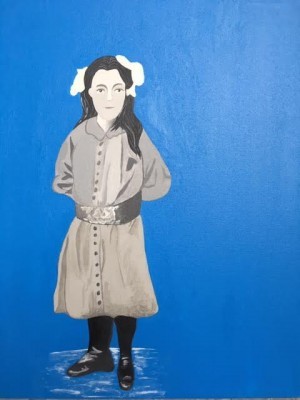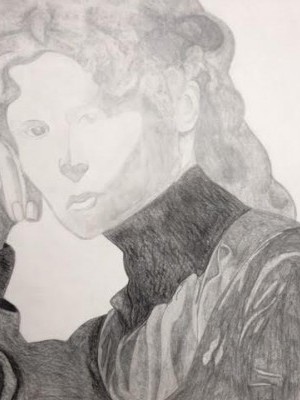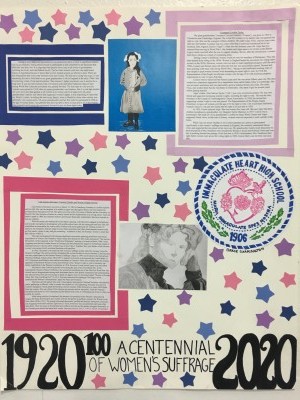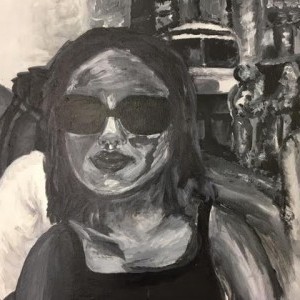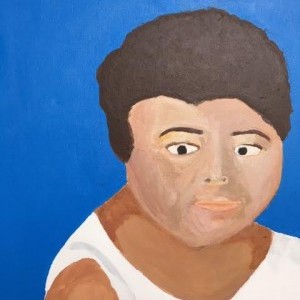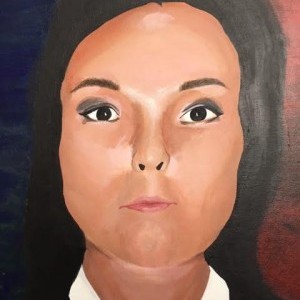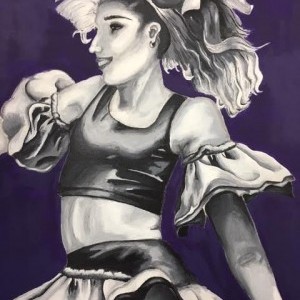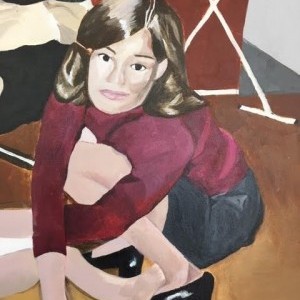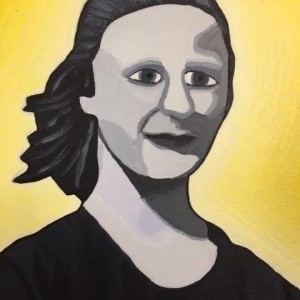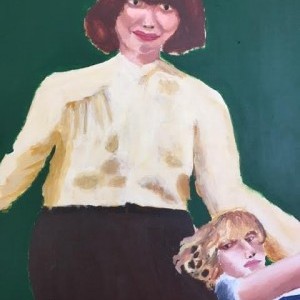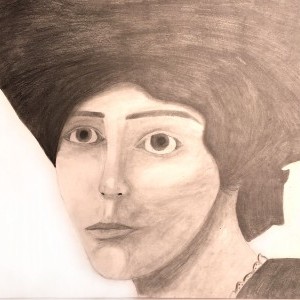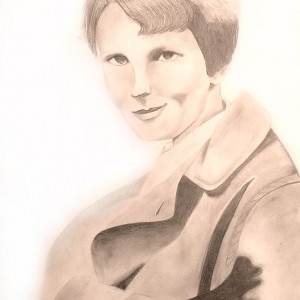Grace Carrington
Immaculate Heart High School | Los Angeles, CA | 9-12th Grade
Inspirational Family Member
Constance Lavinia Franklin
My great grandmother, Constance Lavinia Franklin (“Connie”), was born in 1905 in Chesterton near Cambridge, England. She is the first woman in my family who was granted the right to vote. She was the youngest of three children. Her older sister, Floss, was ten years older than her. Her brother, Leonard, was two years older than Connie and introduced her to her husband, John Algernon Taylor (“Algie”), when she was fourteen years old. Algie had just returned from serving in World War I. Her brother and Algie spent a lot of time at the British Legion which was built after the war to support veterans. Shortly after the introduction, Leonard died from a stroke as a result of contracting polio.
During Connie’s childhood, women could not vote for members of Parliament. They had been banned from voting in the 1830s. Women in England began the movement for voting rights as early as the 1870s. However, women were not able to make significant progress until the early 1900s. Connie was thirteen years old when the first law was successfully passed. Women had been assisting with many jobs during World War I. Taking on the traditional working roles of men helped to push women forward with demanding an equal right to vote. In 1918, the Representation of the People Act allowed women over the age of 30, with minimum property requirements, to vote. It was a first step.
Connie went to school at Free School Lane until she was about fifteen years old. She then worked as a seamstress apprentice for a department store called Eaden Lilley in Cambridge. She was an expert seamstress and was particularly good at making dresses and coats. Her sister, Floss, also worked there but she was better at embroidery. She dated Algie for several years before getting married.
Algie’s father, John Mercer Taylor (“J.M.”) was very involved in politics. He was very liberal and supported increasing women’s rights, including the right to vote. He was the Honorable Secretary of the County of Cambridgeshire Liberal Association. In 1928, the second law supporting women’s right to vote was passed. The Representation of the People (Equal Franchise) Act gave all women over the age of 21 the right to vote. John Mercer would have definitely wanted Connie to vote and she finally had the right to do just that in 1928.
In 1929, Connie married Algie. She was twenty-four years old. She and Algie had three children including my grandmother, Joy Margaret Taylor (Barnes), in 1937. Connie was a homemaker. She made all of my grandmother’s clothes by hand. While Connie and Algie supported liberal views, at that time in history, women were not expected to work outside of the home.
While I am not aware whether or not Connie attended any rallies or participated significantly in the women’s suffrage movement in England, she certainly maintained liberal views and supported the movement in her own way. My grandmother recalls much discussion in their household of Mrs. Pankhurst who founded the Women’s Social and Political Union and was key in pushing forward the passage of the first law in 1918. Unfortunately Mrs. Pankhurst died right before women were given full voting rights in 1928. Connie likely cast her first vote soon after.
Historical Figure I Admire
Lida Gustava Heymann
Lida Gustava Heymann was born on March 15, 1867 in Hamburg, Germany to a coffee importer and his wife. She was the daughter of a middle to upper class bourgeois family and was educated at private schools throughout her life. She spent some time at the University of Berlin and the University of Munich. She later became a teacher at a charity school and the headmistress of a sewing school. Upon her father’s death in 1896, she inherited millions and became financially independent. She never married or had any children. With the money she obtained from her father’s passing, Lida Heymann engaged in philanthropy and founded a progressive kindergarten with an after-school care club for young girls and boys. She also established an association for women office workers with lunch gatherings for working women. In addition, she initiated a club for single women where prostitutes and other disadvantaged women could get free meals, a place to stay, and got counseling. In addition to that, she formed a women’s center that had a library within it.
Heymann participated in the German abolitionist movement opposing prostitution and sexual exploitation of women. She wanted to “help women free themselves from male domination.” She met her life partner, Anita Augspurg, at the “Abolitionist Federation” meeting of women in Berlin, in 1896. Anita Augspurg was the first woman lawyer in Germany and had obtained her degree in Switzerland instead of Germany because it did not allow women to go to law school. Together, they were leaders of the German women’s movement which combined feminism with pacifism.
In 1902, Heymann co-founded the first women’s suffrage society called the German Union for Women’s Suffrage. She and her partner demanded that women be able to vote in elections. Lida Heymann was also a participant in the German Women’s Suffrage League in 1907 and worked in the International Women’s Suffrage Alliance from 1904-1907 to support movements in Europe and the United States. In 1913, Heymann established a more radical association in Germany which was modeled after the militant approach of the British Women’s Social and Political Union. Women’s right to vote in Germany was finally established in the Weimar Constitution in 1918. However, it took several years to go into effect.
Heymann’s early years as a pacifist were during the time of the First World War. At the International Women’s Peace Conference, she wanted an immediate end of the The First World War. She viewed war as disagreements among male-dominated nations who lacked compassion and understanding. She asked women from all over Europe to speak out against war in a document called “Women of Europe, When Will Your Call Ring Out?” In 1915, Heymann attended the meeting at The Hague which established the Women’s International League for Peace and Freedom.
Heymann and her partner also took a stand against anti-Semitic National Socialists who attacked public gatherings in Munich. After a woman was injured in a 1923 gathering, Heymann was part of a women’s delegation which asked the Bavarian interior minister, Franz Schweyer, to expel Adolf Hitler from the country. She was critical of the German government and its war policy. After the National Socialists took power in 1933, Heymann and her partner took exile in Switzerland and lived on a farm run entirely by women. After being exiled to Switzerland, she became vice president of the Women’s International League for Peace and Freedom and worked with her life partner to publish a journal, The Woman in the State, from 1918 to 1933. The journal discussed democratic, pacifist and feminist viewpoints.
Heymann and Augspurg wrote their memoirs, Experienced - Seen. However, it was not published until years after their death.Their last years in Switzerland were difficult and she and her partner struggled financially as the German government had taken their wealth. Heymann died on July 31, 1943 in Zurich, Switzerland.
SOURCES +
What the Project Means to Me
Voting is very important because everyone deserves to have a voice in significant matters such as government. Voting allows people to participate in and contribute to the decisions that affect the way they live. It is important that people have a say in all levels of government including the local, state and federal levels. The fact that women could not vote until recent history is disturbing because it shows that society treated women as inferior to men. There are still inequalities that exist today between men and woman.
We still have a long way to go. It was interesting for me to look back at my great grandmother’s life in England in the early 1900s. She lived during a time of war and revolution. The women’s’ rights movement was in motion for a long time. It was not until women took over factory jobs and other traditional tasks of men during World War I that the movement was pushed forward. The first right to vote laws for women were passed in 1918 when my great grandmother was fourteen. But it would take another ten years for a law that applied to all women over twenty-one to be approved.
My great grandmother’s family was liberal and supported women’s rights. It was interesting to learn that my family’s views, including the men in my family, were so liberal at a time when society was generally very conservative. My great grandmother cast her first vote for parliament in 1928 at the age of twenty-three. I am grateful that she was able to have a voice and to all of the women who worked hard to push the movement forward to give us these rights today.
Explore the Archive
More From This Class
Click on the thumbnails below to view each student's work.Deadline Extended
There's still time to join Women Leading the Way.
Become a part of our storytelling archive. Enroll your class today.
Join the Project

